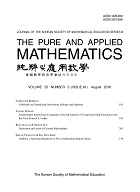 ISSN : 1226-0657
ISSN : 1226-0657
권호 목록
- 2024 (31권)
- 2023 (30권)
- 2022 (29권)
- 2021 (28권)
- 2020 (27권)
- 2019 (26권)
- 2018 (25권)
- 2017 (24권)
- 2016 (23권)
- 2015 (22권)
- 2014 (21권)
- 2013 (20권)
- 2012 (19권)
- 2011 (18권)
- 2010 (17권)
- 2009 (16권)
- 2008 (15권)
- 2007 (14권)
- 2006 (13권)
- 2005 (12권)
- 2004 (11권)
- 2003 (10권)
- 2002 (9권)
- 2001 (8권)
- 2000 (7권)
- 1999 (6권)
- 1998 (5권)
- 1997 (4권)
- 1996 (3권)
- 1995 (2권)
- 1994 (1권)
22권 4호
초록
Abstract
The purpose of this paper is to obtain Opial-type inequalities that are useful to study various qualitative properties of certain differential equations involving impulses. After we obtain some Opial-type inequalities, we apply our results to certain differential equations involving impulses.
초록
Abstract
We show that the set of priors in the representation of Choquet expectation is the one of equivalent martingale measures under some conditions, when given capacity is submodular. It is proven via Peng’s g-expectation and related topics.
초록
Abstract
Using the fixed point method, we prove the Hyers-Ulam stability of lin- ear mappings in Banach modules over a unital C*-algebra and in non-Archimedean Banach modules over a unital C*-algebra associated with the orthogonally Cauchy- Jensen additive functional equation.
초록
Abstract
We present smooth simply connected closed 4k-dimensional manifolds N := N<sub>k</sub>, for each k ∈ {2, 3, ⋯}, with distinct symplectic deformation equivalence classes [[ω<sub>i</sub>]], i = 1, 2. To distinguish [[ω<sub>i</sub>]]’s, we used the symplectic Z invariant in <xref>[4]</xref> which depends only on the symplectic deformation equivalence class. We have computed that Z(N, [[ω<sub>1</sub>]]) = ∞ and Z(N, [[ω<sub>2</sub>]]) < 0.
초록
Abstract
In this paper, we solve the additive ρ-functional equations
초록
Abstract
In this paper, we solve the additive ρ-functional equations
초록
Abstract
In <xref>[1]</xref>, the definition of C*-Lie ternary (σ,τ,ξ)-derivation is not well-defined and so the results of [<xref>1</xref>, Section 4] on C*-Lie ternary (σ,τ,ξ)-derivations should be corrected.
초록
Abstract
We will show the general solution of the functional equation f(x + ay) + f(x − ay) + 2(a<sup>2</sup> − 1)f(x) = a<sup>2</sup>f(x + y) + a<sup>2</sup>f(x − y) + 2a<sup>2</sup>(a<sup>2</sup> − 1)f(y) and investigate the stability of quartic Lie *-derivations associated with the given functional equation.
초록
Abstract
Kato<xref>[6]</xref> and Torres<xref>[9]</xref> characterized the Weierstrass semigroup of ramification points on h-hyperelliptic curves. Also they showed the converse results that if the Weierstrass semigroup of a point P on a curve C satisfies certain numerical condition then C can be a double cover of some curve and P is a ramification point of that double covering map. In this paper we expand their results on the Weierstrass semigroup of a ramification point of a double covering map to the Weierstrass semigroup of a pair (P, Q). We characterized the Weierstrass semigroup of a pair (P, Q) which lie on the same fiber of a double covering map to a curve with relatively small genus. Also we proved the converse: if the Weierstrass semigroup of a pair (P, Q) satisfies certain numerical condition then C can be a double cover of some curve and P, Q map to the same point under that double covering map.
